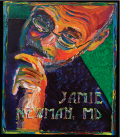Almost a 5-star column
The “Great Satisfaction Madness” of 2027 is over.
The “Great Satisfaction Madness” of 2027 is over.
The whole business started decades ago in a relatively innocuous, though slightly annoying, manner. As quaint as it sounds, companies just wanted to improve their products and hospitals their services. For a few years, the occasional request to fill out a survey or questionnaire was easily complied with or ignored. As the end of the “Age of Paper” drew to a close, an increasing number of these forms became computerized. Coupled with increased governmental and corporate surveillance, surveys and satisfaction scores took on a life of their own.

Within a few years, everyone was rating an ever-widening net of activities. Restaurants, movies, hotels, and even nursing homes were striving for the increasingly elusive 5-star rating. People were rating everything, from their lunches to their love lives. And then the companies began rating the consumers. This started with a car service that rated its riders. It got to the point that a bad rating from a barista at a coffeehouse might lead to substandard macchiato preparation in any cafe across the state.
Legislators tried to regulate the topic, but any time they did, their approval ratings and re-electability would plummet. The Survey Cartel and its highly rated lobbyists took no prisoners. Soon they expanded their reach into the fertile medical market. How was your doctor? Your nurse? Your therapist? Your unit secretary? Your cafeteria? (The last of these never got more than 3.5 stars on a good day.) Even the person who pushed the wheelchair was rated. And how about the chair itself? Comfy?
And then physicians, in a counterstroke, began to rate their patients. Patients with bad ratings had a hard time finding private insurance at an affordable rate. No plan wanted troublemakers or system abusers.
Soon clinicians were paralyzed for fear of a bad evaluation that might knock them off a plan or decrease their per-member/per-month compensation, while patients were afraid to complain because of the risk that they would be booted from coverage. Hospitals dedicated a huge portion of their budgets to satisfaction support service lines. Even uninsured patients were loath to give anything but a good report for fear of retribution, despite the supposed blind nature of the reviews.
In the end, it took top-down and bottom-up change. First there was a president who had no further political aspirations, in part because of his metastatic melanoma (a not highly rated tumor). He could act with no concerns about his reelection. Things really came to a head, though, when all 3 major server farms were bombed in a coordinated effort by the terrorist group Unrated Army. Satisfaction surveys were banned from America in a matter of weeks, despite a vicious last-minute 0-star propaganda effort to minimize the power of the president.
The solution was found in a 1955 science fiction story by Isaac Asimov called “Franchise.” In this tale, a computer was able to predict the outcome of an election and eventually select the new president of the U.S. based on the vote of just 1 person. The concept was applied, using modern computer analysis, not just for elections but for car purchases and heart transplants, cafes and cemeteries. One algorithm–selected person made the call for us all, freeing the rest of the population from survey fatigue.
That solution had its disadvantages, too, though. I broke my arm last night. I'd been playing with the kids on our trampoline when I was distracted by my wife screaming to tell me that they were picking someone from our town to be the national health survey surrogate. How exciting. I was more concerned about my broken arm. I did not love the local emergency department. They had somehow managed to mess up everything they had ever done for me.
As I was wheeled in the ED this time, however, something was different. The room swarmed with employees. They were smiling and helpful and were trying to make the patients feel special. How nice. An announcement came on the waiting room TV—the choice of the health representative had been narrowed to a male, 35 to 50 years old. Suddenly the quality of care for the geriatric women dropped; the kids were ignored. There were a few of us in the target demographic in the emergency area, and we were all treated like kings. They even offered me sparkling water or a latte while I waited (only briefly, they assured me) for my X-rays to develop. My pillow was fluffed, my blanket heated, but not too warm. The physician assured me it was a beautiful break and one he would be very happy to fix; it would be his honor to provide patient-centered, high-quality, efficient care to me.
I woke up from anesthesia. I was no longer in a private room, but in a quad with a loudly screaming man, a snorer, and a flatulent farmer. I rang my bell but nobody came. What had happened to the wonderful staff and great treatment?
I peered out the door and across the hall to a door partially open. A whole team stood eagerly around a mid-40s man who had a big smile on his face. The satisfaction rater had been announced.
As for me, my arm eventually healed, and though I can't flex my fourth and fifth fingers easily, the hospital has a 5-star rating.
*Thanks to Umesh Sharma for making me think about satisfaction.



